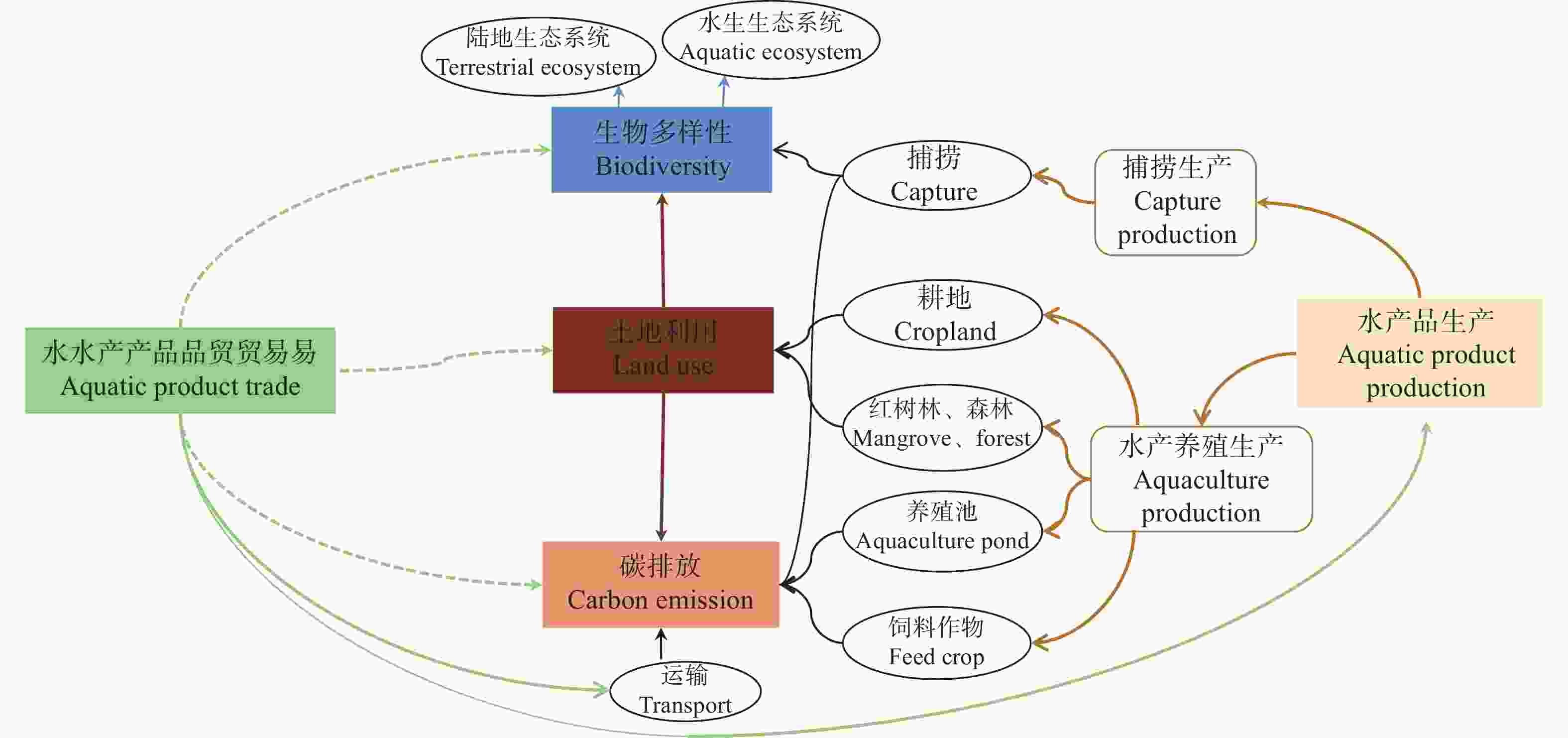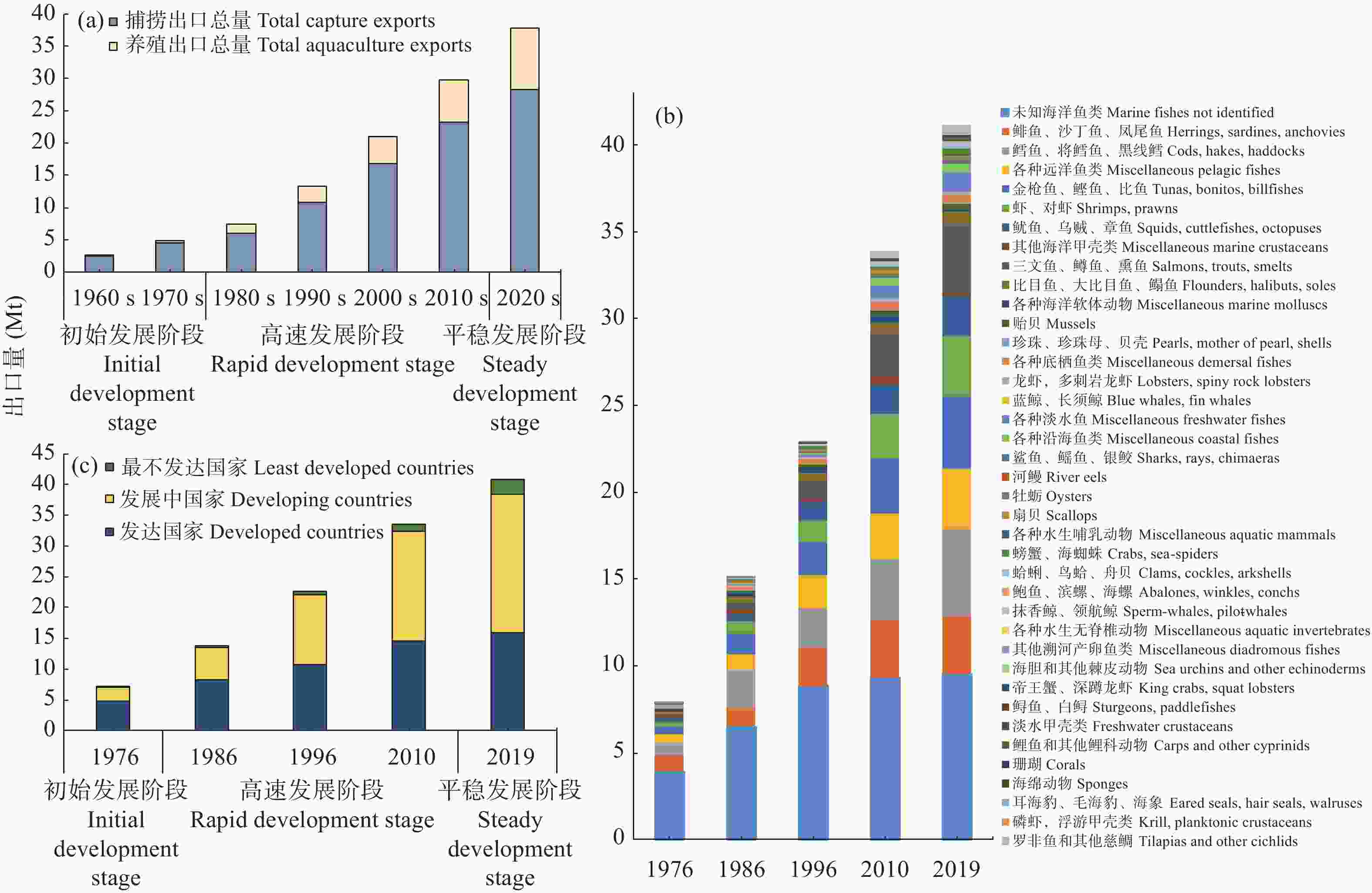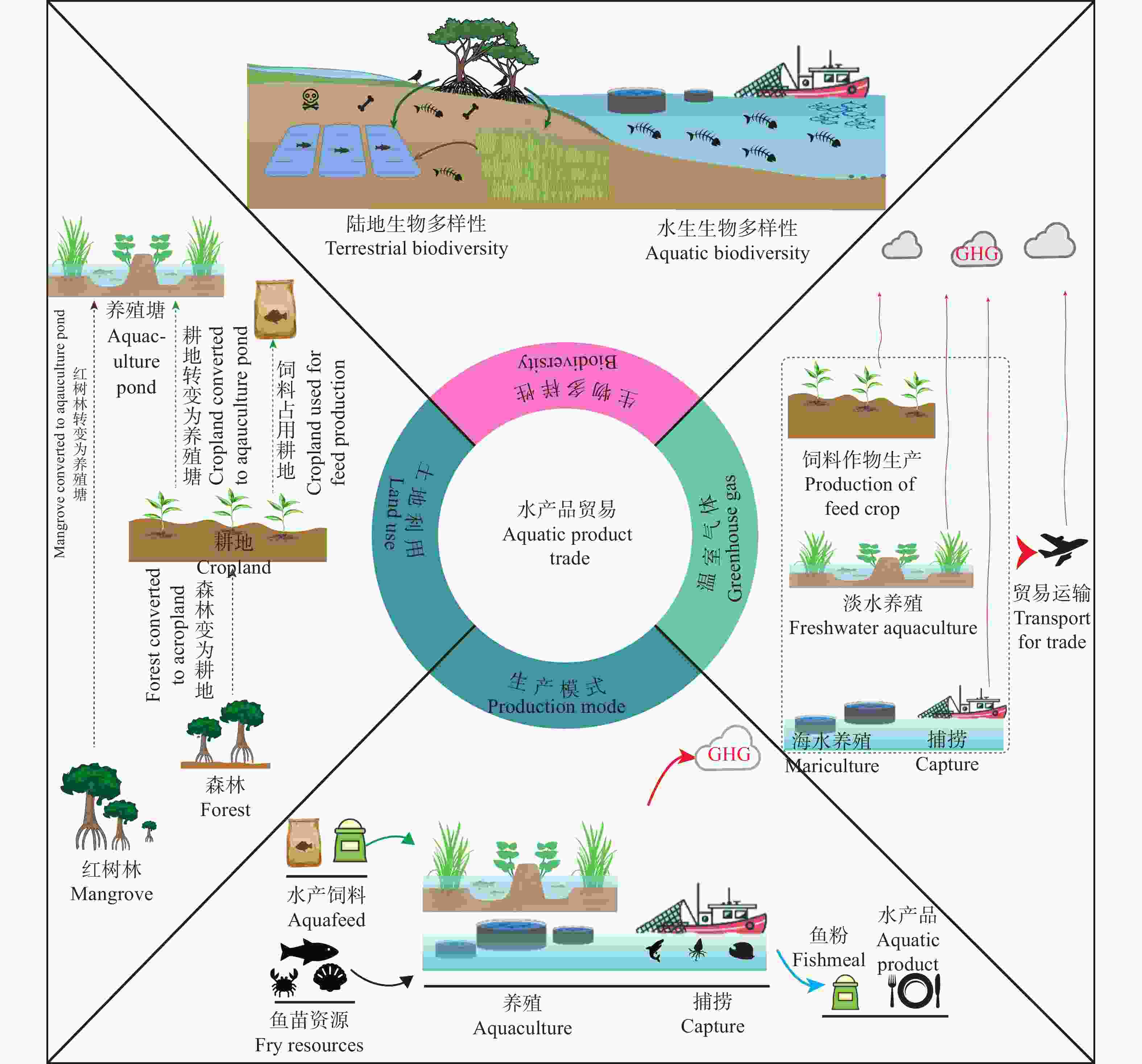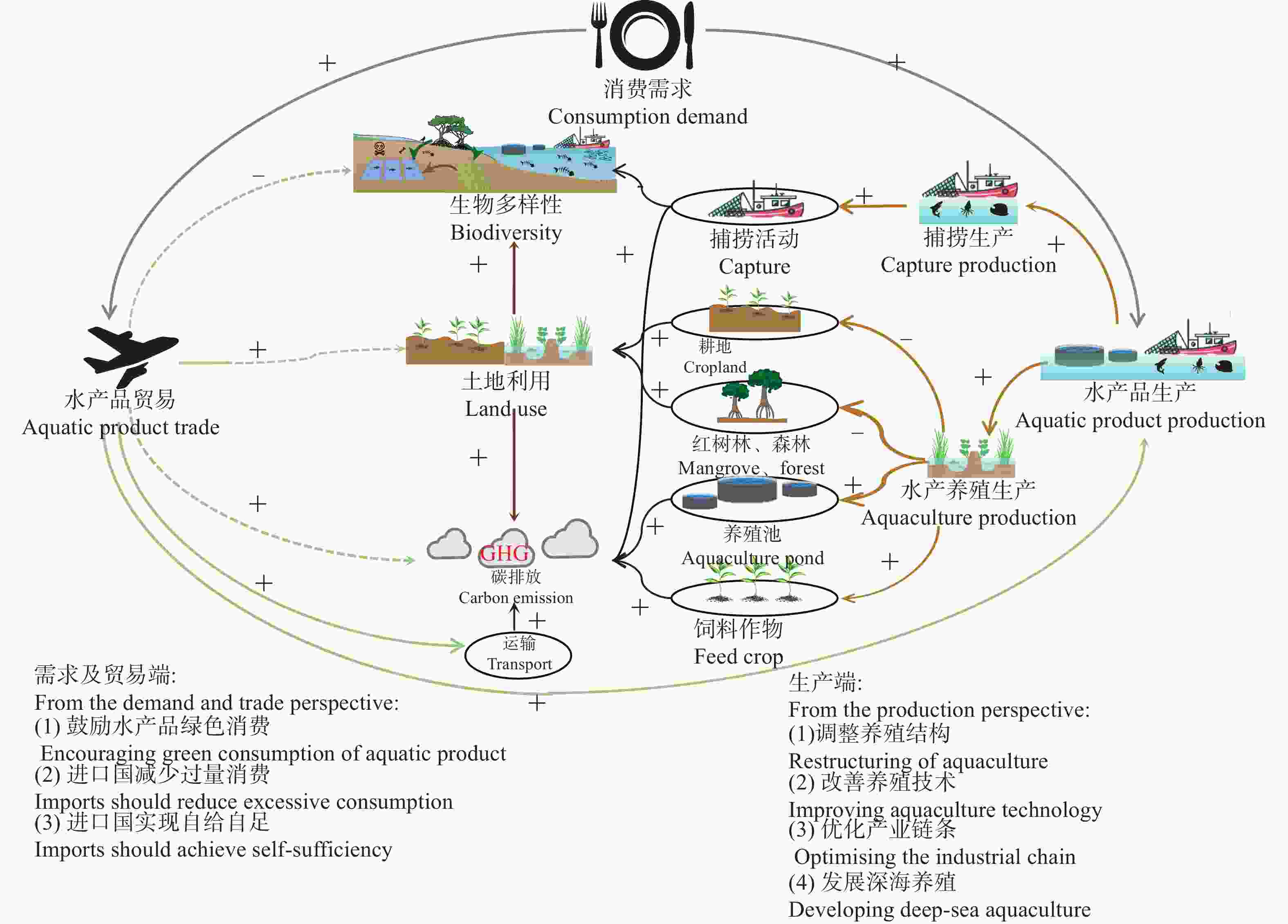-
摘要: 目前全球约37%的水产品进入国际贸易而非本地消费, 因此水产品贸易与全球资源和环境可持续性的联系日益密切。然而, 现有研究多集中于分析水产品替代畜禽产品导致的资源环境代价变化, 而针对水产品贸易与“资源-环境-生物多样性”影响的研究还较缺乏。本文利用环境足迹和全生命周期相结合的方法, 综述了水产品的贸易量、贸易品种与贸易国家的变化规律, 并依据贸易与资源及环境的关系, 分析了水产品贸易对土地利用、碳排放和生物多样性的影响。结果发现, 2020年水产品出口量较1976年增长了5倍, 且贸易增速呈现出“先快后稳”的趋势。水产品贸易国由欧洲南部扩大至全球范围。捕捞水产品, 如沙丁鱼、鳕鱼和金枪鱼是主要的贸易品种; 养殖水产品在总水产贸易产品中的比重快速增加, 由1976年的5%增加至2020年的25%。水产品贸易中养殖产品的增加影响全球土地利用变化、虚拟温室气体排放, 以及水生和陆地生态系统生物多样性。因此, 未来若要实现全球水产品可持续生产和消费, 需发达国家和发展中国家间共享水产品先进生产技术、优化贸易结构、调整贸易品种。例如, 在生产端优化养殖结构、技术和产业链, 在需求端减少对高资源环境代价品种的消费, 在贸易端限制高资源环境代价品种的交易。Abstract: Currently, the aquatic product trade played an increasingly important role on global resources and environment due to 37% of global aquatic product is traded rather than consumed locally. Previous studies mainly analyzed the resources and environmental costs caused by the substitution of aquatic product for livestock product. However, little is about the impacts of aquatic product trade on ‘resource-environment-biodiversity’ system. Here, a review was conducted by a combined method of environmental footprint and life cycle assessment. The review was focus on (1) the change of trade volume, trade species and trade countries; (2) the impact of aquatic product trade on land use, greenhouse gas emissions (GHG) and biodiversity. The results showed that the export volume of aquatic product in 2020 increased five times compared to 1976, and the growth rate of trade showed ‘fast and then stable’. The aquatic product trade has expanded from southern Europe to the world. Capture product (such as sardines, cod and tuna) was the major species of trade. However, the share of aquaculture product in total aquatic trade product increased linearly since 1976, which increased from 5% in 1976 to 25% in 2020. The increasing of aquaculture product trade affects global land use change, virtual GHG, and biodiversity in aquatic and terrestrial systems. Therefore, to achieve sustainability of global aquatic product in the future, it is necessary to share advanced production technology, optimize trade structure and adjust trade species globally. More specifically, producers should optimize aquaculture structure, technology and industrial chain; consumer should reduce consumption and trade aquatic product with high resources and environmental costs.
-
Key words:
- Aquatic product trade /
- Land use /
- Carbon emission /
- Biodiversity
-
图 2 1960s—2020s世界水产品出口变化情况 (以水产品净重计)
(a)捕捞和养殖出口量图; (b)水产品贸易品种变化图; (c)水产品主要出口国变化图; 数据来源: FAO FishStatJ statistics software 2022; 国家以经济水平为依据进行分类。(a) Exports of capture and aquaculture; (b) The change of trade species of aquatic product; (c) The change of major exporters of aquatic product. Data source: FAO FishStatJ statistics software 2022; countries are classified on the basis of economic level.
Figure 2. The change of the world export of aquatic product (net aquatic product weight)
-
[1] ZHANG W B, BELTON B, EDWARDS P, et al. Aquaculture will continue to depend more on land than sea[J]. Nature, 2022, 603(7900): E2−E4 doi: 10.1038/s41586-021-04331-3 [2] 孙瑞杰, 李双建. 世界海洋渔业发展趋势研究及对我国的启示[J]. 海洋开发与管理, 2014, 31(5): 85−89 doi: 10.3969/j.issn.1005-9857.2014.05.021SUN R J, LI S J. The development trend research of the world marine fishery and its enlightenment to our country[J]. Ocean Development and Management, 2014, 31(5): 85−89 doi: 10.3969/j.issn.1005-9857.2014.05.021 [3] Food and Agriculture Organisation of the United Nations. The state of world fisheries and aquaculture 2020[M]. Rome: FAO, 2020 [4] COSTELLO C, CAO L, GELCICH S, et al. The future of food from the sea[J]. Nature, 2020, 588(7836): 95−100 doi: 10.1038/s41586-020-2616-y [5] Food and Agriculture Organisation of the United Nations. The state of world fisheries and aquaculture 2022[M]. Rome: FAO, 2022 [6] DELGADO C L, WADA N, ROSEGRANT M W, et al. Fish to 2020: supply and demand in changing global markets[M]. The WorldFish Center, 2003 [7] WAITE R, BEVERIDGE M C M, BRUMMETT R E, et al. Improving productivity and environmental performance of aquaculture[R]. Washington: World Resources Institute, 2014 [8] BÉNÉ C, LAWTON R, ALLISON E H. “Trade Matters in the Fight Against Poverty”: Narratives, Perceptions, and (Lack of) Evidence in the Case of Fish Trade in Africa[J]. World Development, 2010, 38(7): 933−54 doi: 10.1016/j.worlddev.2009.12.010 [9] EDWARD P. Examining Inequality: Who Really Benefits from Global Growth?[J]. World Development, 2006, 34(10): 1667−95 doi: 10.1016/j.worlddev.2006.02.006 [10] SMITH M D, ROHEIM C A, CROWDER L B, et al. Sustainability and global seafood[J]. Science, 2010, 327(5967): 784−786 doi: 10.1126/science.1185345 [11] MACLEOD M J, HASAN M R, ROBB D H F, et al. Quantifying greenhouse gas emissions from global aquaculture[J]. Scientific Reports, 2020, 10(1): 11679 doi: 10.1038/s41598-020-68231-8 [12] TROELL M, NAYLOR R L, METIAN M, et al. Does aquaculture add resilience to the global food system?[J]. Proceedings of the National Academy of Sciences, 2014, 111(37): 13257−63 doi: 10.1073/pnas.1404067111 [13] WIEDMANN T. Impacts Embodied in Global Trade Flows[M]//Taking Stock of Industrial Ecology. Cham; Springer International Publishing. 2016: 159–80 [14] ASCHE F, BELLEMARE M F, ROHEIM C, et al. Fair Enough? Food Security and the International Trade of Seafood[J]. World Development, 2015, 67: 151−60 doi: 10.1016/j.worlddev.2014.10.013 [15] TVETERÅS S, ASCHE F, BELLEMARE M F, et al. Fish is food - the FAO’s fish price index[J]. PloS one, 2012, 7(5): e36731 doi: 10.1371/journal.pone.0036731 [16] 清光照夫, 岩奇寿南. 水产经济学[M]. 北京: 海洋出版社, 1996QING G Z F, YAN Q S N. Fishery Economics[M]. Beijing: China Ocean Press, 1996 [17] 黄季焜, 徐志刚, 李宁辉, 等. 新一轮贸易自由化与中国农业、贫困和环境[J]. 中国科学基金, 2005(03): 142−146 doi: 10.3969/j.issn.1000-8217.2005.03.005HUANG J k, Xu Z G, Li N H, et al. A new round of trade liberalization, China’s agriculture, poverty and environment[J]. Bulletin of National Natural Science Foundation of China, 2005(03): 142−146 doi: 10.3969/j.issn.1000-8217.2005.03.005 [18] 黄季焜, 解伟, 盛誉, 等. 全球农业发展趋势及2050年中国农业发展展望[J]. 中国工程科学, 2022, 24(01): 29−37HUANG J K, Xie W, Sheng Y, et al. Trends of global agriculture and prospects of China’s Agriculture Toward 2050[J]. Strategic Study of CAE, 2022, 24(01): 29−37 [19] DAVIS K F, GEPHART J A, EMERY K A, et al. Meeting future food demand with current agricultural resources[J]. Global Environmental Change, 2016, 39: 125−132 doi: 10.1016/j.gloenvcha.2016.05.004 [20] BRUNNER E J, JONES P J S, FRIEL S, et al. Fish, human health and marine ecosystem health: policies in collision[J]. International Journal of Epidemiology, 2009, 38(1): 93−100 doi: 10.1093/ije/dyn157 [21] Anderson J L, Martínez-Garmendia J. Trends in international seafood trade[M]//Anderson J L. Trends in intzernational seafood trade. , Elsevier, 2003, 39–54 [22] BOSTOCK J, MCANDREW B, RICHARDS R, et al. Aquaculture: global status and trends[J]. Philosophical Transactions of the Royal Society B:Biological Sciences, 2010, 365(1554): 2897−2912 doi: 10.1098/rstb.2010.0170 [23] ASCHE F, YANG B X, GEPHART J A, et al. China’s seafood imports-Not for domestic consumption?[J]. Science, 2022, 375(6579): 386−388 doi: 10.1126/science.abl4756 [24] Anderson J L, ASCHE F, GARLOCK T. Globalization and commoditization: the transformation of the seafood market[J]. Journal of Commodity Markets, 2018, 12: 2−8 doi: 10.1016/j.jcomm.2017.12.004 [25] 第17届上海国际渔业博览会. 欧盟、中国、美国推动全球海鲜需求增长[EB/OL]. [2022-06-01] https://www.worldseafoodshanghai.com/xinwenmeiti/2425.htmlth Shanghai International Fisheries and Seafood Exhibition. EU, China and the United States promote the growth of global seafood demand[EB/OL]. [2022-06-01]. https://www.worldseafoodshanghai.com/xinwenmeiti/2425.html [26] 史磊, 秦宏, 刘龙腾. 世界海洋捕捞业发展概况、趋势及对我国的启示[J]. 海洋科学, 2018, 42(11): 126−134 doi: 10.11759/hykx20181011002SHI L, QIN H, LIU L T. Development situation and trend of world marine fishing industry and its enlightenment to China[J]. Marine Sciences, 2018, 42(11): 126−134 doi: 10.11759/hykx20181011002 [27] ZHANG W B, LIU M, YVONNE S, et al. Fishing for feed in China: facts, impacts and implications[J]. Fish and Fisheries, 2020, 21(1): 47−62 doi: 10.1111/faf.12414 [28] Food and Agriculture Organisation of the United Nations. The state of world fisheries and aquaculture 2016[M]. Rome: FAO, 2016 [29] TVETERåS S, ASCHE F. International fish trade and exchange rates: an application to the trade with salmon and fishmeal[J]. Applied Economics, 2008, 40(13): 1745−55 doi: 10.1080/00036840600905134 [30] NAYLOR R L, GOLDBURG R J, MOONEY H, et al. Nature’s subsidies to shrimp and salmon farming[J]. Science, 1998, 282(5390): 883−84 doi: 10.1126/science.282.5390.883 [31] Food and Agriculture Organisation of the United Nations. The state of world fisheries and aquaculture 1998[M]. Rome: FAO, 1998 [32] Food and Agriculture Organisation of the United Nations. The state of world fisheries and aquaculture 2006[M]. Rome: FAO, 2006 [33] KUMAR M S. Erratum to: sustainable management of fisheries and aquaculture for food security and nutrition: policies requirements and actions[J]. Agricultural Research, 2014, 3: 278 doi: 10.1007/s40003-014-0122-x [34] SWARTZ W, SUMAILA R, WATSON R, et al. Sourcing seafood for the three major markets the EU, Japan and the USA[J]. Marine Policy, 2010, 34: 1366−73 doi: 10.1016/j.marpol.2010.06.011 [35] CHEUNG W W L, WATSON R, et al. Food security implications of global marine catch losses due to overfishing[J]. Journal of Bioeconomics, 2010, 12(3): 183−200 doi: 10.1007/s10818-010-9090-9 [36] 李晨, 汪琳琳, 邵桂兰. 水产品贸易对渔业碳排放强度的影响−基于中介模型与门槛模型的检验[J]. 资源科学, 2021, 43(10): 2130−2145 doi: 10.18402/resci.2021.10.16LI C, WANG L L, SHAO G L. The impact of aquatic product trade on the intensity of fishery carbon emissions: Based on intermediary and threshold models[J]. Resources Science, 2021, 43(10): 2130−2145 doi: 10.18402/resci.2021.10.16 [37] YUAN J J, XIANG J, LIU DY, et al. Rapid growth in greenhouse gas emissions from the adoption of industrial–scale aquaculture[J]. Nature Climate Change, 2019, 9(4): 318−322 doi: 10.1038/s41558-019-0425-9 [38] PAPROCKI K, CONS J. Life in a shrimp zone: aqua- and other cultures of Bangladesh’s coastal landscape[J]. The Journal of Peasant Studies, 2014, 41(6): 1109−30 doi: 10.1080/03066150.2014.937709 [39] ELTHOLTH M, FORNACE K, GRACE D, et al. Characterisation of production, marketing and consumption patterns of farmed tilapia in the Nile Delta of Egypt[J]. Food Policy, 2015, 51: 131−43 doi: 10.1016/j.foodpol.2015.01.002 [40] BéNé C, BARANGE M, SUBASINGHE R, et al. Feeding 9 billion by 2050–Putting fish back on the menu[J]. Food Security, 2015, 7(2): 261−74 doi: 10.1007/s12571-015-0427-z [41] TACON A G J, METIAN M. Feed Matters: Satisfying the Feed Demand of Aquaculture[J]. Reviews in Fisheries Science & Aquaculture, 2015, 23(1): 1−10 [42] 严志强, 颜章雄, 胡宝清, 等. 虚拟土地、虚拟土地战略与区域土地资源优化配置管理的理论探讨[J]. 广西社会科学, 2007(10): 70−74 doi: 10.3969/j.issn.1004-6917.2007.10.018YAN Z Q, YAN Z X, HU B Q, et al. Virtual land, virtual land strategy and optimal allocation management of regional land resources[J]. Social Sciences in Guangxi, 2007(10): 70−74 doi: 10.3969/j.issn.1004-6917.2007.10.018 [43] PARKER R W R, BLANCHARD J L, GARDNER C, et al. Fuel use and greenhouse gas emissions of world fisheries[J]. Nature Climate Change, 2018, 8(4): 333−7 doi: 10.1038/s41558-018-0117-x [44] COTTRELL R S, FLEMING A, FULTON E A, et al. Considering land–sea interactions and trade–offs for food and biodiversity[J]. 2018, 24(2): 580–96 [45] JIANG Q T, BHATTARAI N, PAHLOW M, et al. Environmental sustainability and footprints of global aquaculture[J]. Resources, Conservation and Recycling, 2022, 180: 106183 doi: 10.1016/j.resconrec.2022.106183 [46] ZIEGLER F, WINTHER U, HOGNES E S, et al. The carbon footprint of norwegian seafood products on the global seafood market[J]. Journal of Industrial Ecology, 2013, 17(1): 103−16 doi: 10.1111/j.1530-9290.2012.00485.x [47] KASTNER T, CHAUDHARY A, GINGRICH S, et al. Global agricultural trade and land system sustainability: Implications for ecosystem carbon storage, biodiversity, and human nutrition[J]. One Earth, 2021, 4(10): 1425−1443 doi: 10.1016/j.oneear.2021.09.006 [48] LENZEN M, MORAN D, KANEMOTO K, et al. International trade drives biodiversity threats in developing nations[J]. Nature, 2012, 486(7401): 109−12 doi: 10.1038/nature11145 [49] RITCHIE H, ROSER M. Fish and Overfishing[EB/OL]. Our World in Data. [2021-10]. https://ourworldindata.org/fish-and-overfishing#what-does-sustainable-fishing-mean [50] GUILLEN J, NATALE F, CARVALHO N, et al. Global seafood consumption footprint[J]. Ambio, 2019, 48(2): 111−22 doi: 10.1007/s13280-018-1060-9 [51] AKAWA T, NASHIMA F P. A sustainability analysis of Namibian marine fishery[J]. Journal of Human Resource and Sustainability Studies, 2013, 1(01): 1−7 doi: 10.4236/jhrss.2013.11001 [52] XIA W T, QU X, ZHANG Y X, et al. Effects of aquaculture on lakes in the central Yangtze River Basin, China, III: Heavy Metals[J]. North American Journal of Aquaculture, 2018, 80(4): 436−46 doi: 10.1002/naaq.10060 [53] 黄永汉, 王桃新, 马从丽. 水产养殖发展与生物多样性保护[J]. 中国农业信息, 2015(3): 86HUANG Y H, WANG T X, MA C L. Aquaculture development and biodiversity protection[J]. China Agricultural Informatics, 2015(3): 86 [54] 王光辉, 余云军, 于会国. 水产养殖发展与生物多样性保护[J]. 海洋开发与管理, 2007(5): 110−114 doi: 10.3969/j.issn.1005-9857.2007.05.022WANG G H, YU Y J, YU H G. Aquaculture development and biodiversity protection[J]. Ocean Development and Management, 2007(5): 110−114 doi: 10.3969/j.issn.1005-9857.2007.05.022 [55] MOLNAR J L, GAMBOA R L, REVENGA C, et al. Assessing the global threat of invasive species to marine biodiversity[J]. Frontiers in Ecology and the Environment, 2008, 6(9): 485−92 doi: 10.1890/070064 [56] FROEHLICH H E, RUNGE C A, GENTRY R R, et al. Comparative terrestrial feed and land use of an aquaculture-dominant world[J]. 2018, 115(20): 5295–300 [57] WILLIAMS D R, CLARK M, BUCHANAN G M, et al. Proactive conservation to prevent habitat losses to agricultural expansion[J]. Nature Sustainability, 2021, 4(4): 314−22 [58] ZABEL F, DELZEIT R, SCHNEIDER J M, et al. Global impacts of future cropland expansion and intensification on agricultural markets and biodiversity[J]. Nature Communications, 2019, 10(1): 2844 doi: 10.1038/s41467-019-10775-z [59] POORE J, NEMECEK T. Reducing food’s environmental impacts through producers and consumerss[J]. Science, 2018, 360(6392): 987−992 doi: 10.1126/science.aaq0216 [60] VöRöSMARTY C J, MCINTYRE P B, GESSNER M O, et al. Global threats to human water security and river biodiversity[J]. Nature, 2010, 467(7315): 555−61 doi: 10.1038/nature09440 [61] MCINTYRE P B, REIDY LIERMANN C A, REVENGA C. Linking freshwater fishery management to global food security and biodiversity conservation[J]. Proceedings of the National Academy of Sciences, 2016, 113(45): 12880−5 doi: 10.1073/pnas.1521540113 [62] TILMAN D, CLARK M. Global diets link environmental sustainability and human health[J]. Nature, 2014, 515(7528): 518−22 doi: 10.1038/nature13959 [63] SCARBOROUGH P, APPLEBY P N, MIZDRAK A, et al. Dietary greenhouse gas emissions of meat-eaters, fish-eaters, vegetarians and vegans in the UK[J]. Climatic Change, 2014, 125(2): 179−92 doi: 10.1007/s10584-014-1169-1 [64] NAYLOR R L, KISHORE A, SUMAILA U R, et al. Blue food demand across geographic and temporal scales[J]. Nature Communications, 2021, 12: 5413 doi: 10.1038/s41467-021-25516-4 [65] WILLETT W, ROCKSTRöM J, LOKEN B, et al. Food in the Anthropocene: the EAT–Lancet Commission on healthy diets from sustainable food systems[J]. The Lancet, 2019, 393(10170): 447−92 doi: 10.1016/S0140-6736(18)31788-4 [66] GEPHART J A, HENRIKSSON P J G, PARKER R W R, et al. Environmental performance of blue foods[J]. Nature, 2021, 597(7876): 360−65 doi: 10.1038/s41586-021-03889-2 -






 下载:
下载:






